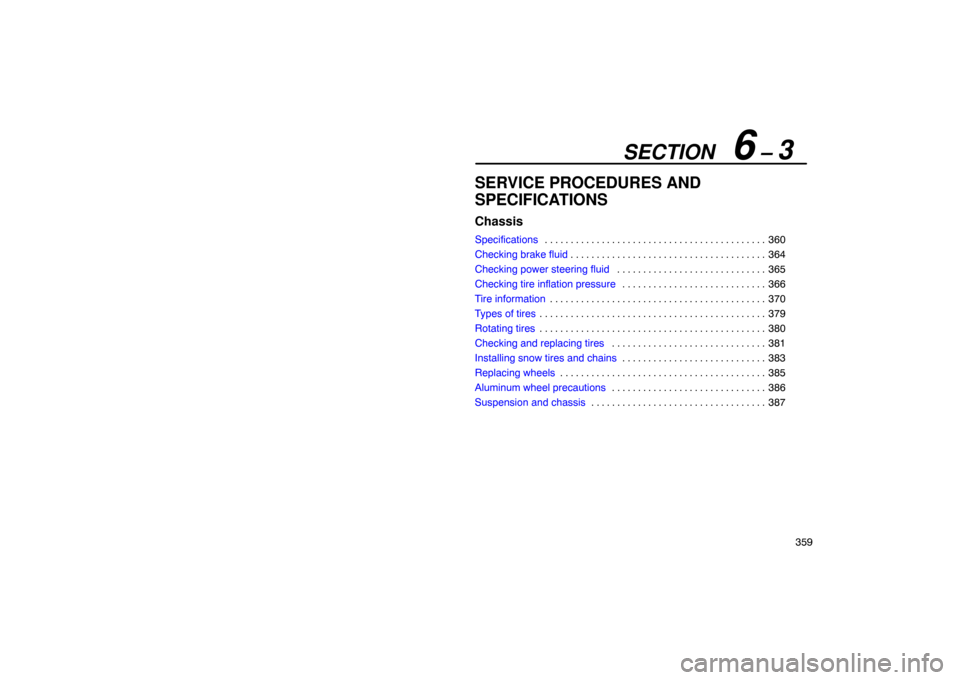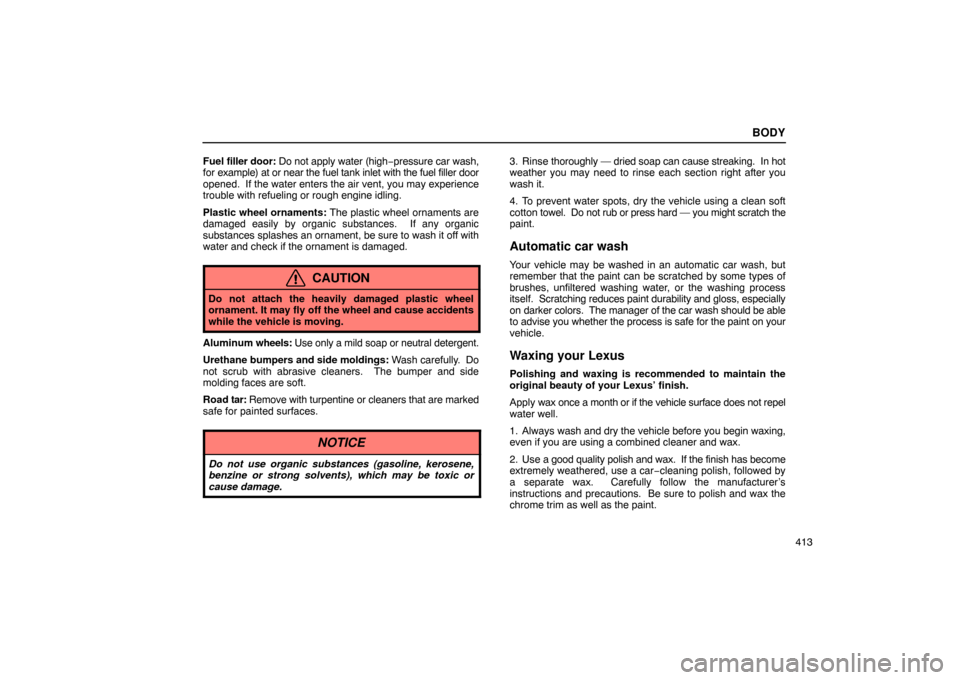Page 360 of 438
SECTION 6 – 2
343
SERVICE PROCEDURES AND
SPECIFICATIONS
Engine
Specifications344
. . . . . . . . . . . . . . . . . . . . . . . . . . . . . . . . . . . . .\
. . . . . .
Fuel 347
. . . . . . . . . . . . . . . . . . . . . . . . . . . . . . . . . . . . \
. . . . . . . . . . . . . . . .
Fuel pump shut off system 349
. . . . . . . . . . . . . . . . . . . . . . . . . . . . . . . .
Facts about engine oil consumption 349
. . . . . . . . . . . . . . . . . . . . . . . .
Used engine oil 351
. . . . . . . . . . . . . . . . . . . . . . . . . . . . . . . . . . . . .\
. . . . .
Checking the engine oil level 351
. . . . . . . . . . . . . . . . . . . . . . . . . . . . . .
Checking the engine coolant level 355
. . . . . . . . . . . . . . . . . . . . . . . . . .
Checking the radiator and condenser 356
. . . . . . . . . . . . . . . . . . . . . . .
Spark plugs 357
. . . . . . . . . . . . . . . . . . . . . . . . . . . . . . . . . . . . .\
. . . . . . . .
Page 376 of 438

SECTION 6 – 3
359
SERVICE PROCEDURES AND
SPECIFICATIONS
Chassis
Specifications360
. . . . . . . . . . . . . . . . . . . . . . . . . . . . . . . . . . . . .\
. . . . . .
Checking brake fluid 364
. . . . . . . . . . . . . . . . . . . . . . . . . . . . . . . . . . . . .\
.
Checking power steering fluid 365
. . . . . . . . . . . . . . . . . . . . . . . . . . . . .
Checking tire inflation pressure 366
. . . . . . . . . . . . . . . . . . . . . . . . . . . .
Tire information 370
. . . . . . . . . . . . . . . . . . . . . . . . . . . . . . . . . . . . .\
. . . . .
Types of tires 379
. . . . . . . . . . . . . . . . . . . . . . . . . . . . . . . . . . . . .\
. . . . . . .
Rotating tires 380
. . . . . . . . . . . . . . . . . . . . . . . . . . . . . . . . . . . . .\
. . . . . . .
Checking and replacing tires 381
. . . . . . . . . . . . . . . . . . . . . . . . . . . . . .
Installing snow tires and chains 383
. . . . . . . . . . . . . . . . . . . . . . . . . . . .
Replacing wheels 385
. . . . . . . . . . . . . . . . . . . . . . . . . . . . . . . . . . . . .\
. . .
Aluminum wheel precautions 386
. . . . . . . . . . . . . . . . . . . . . . . . . . . . . .
Suspension and chassis 387
. . . . . . . . . . . . . . . . . . . . . . . . . . . . . . . . . .
Page 389 of 438
CHASSIS
372
DOT and Tire Identification Number (TIN)
�The illustration indicates typical DOT and Tire
Identification Number (TIN).
1“DOT” symbol
2Tire Identification Number (TIN)
3Tire manufacturer’s identification mark
4Tire size code
5Manufacturer’s optional tire type code
6Manufacturing week
7Manufacturing year
The “DOT” symbol certifies that the tire conforms to
applicable Federal Motor Vehicle Safety Standards.
Tire size
� The illustration indicates typical tire size.
1Tire use (P=Passenger car, T=Temporary
use)
2Section width (in millimeters)
3Aspect ratio (tire height to section width)
4Tire construction code
(R=Radial, D=Diagonal)
5Wheel diameter (in inches)
6Load index (2 digits or 3 digits)
7Speed symbol (alphabet with one letter)
Page 390 of 438
CHASSIS
373
�1Section width
2Tire height
3Wheel diameter
Name of each section of tire
�1Bead
2Sidewall
3Shoulder
4Tread
5Belt
6Inner liner
7Reinforcing rubber
8Carcass
9Rim lines
10Bead wires
11Chafer
Page 391 of 438

CHASSIS
374
Uniform tire quality grading
This information has been prepared in accordance
with regulations issued by the National Highway
Traffic Safety Administration of the U.S.
Department of Transportation. It provides the
purchasers and/or prospective purchasers of
Lexus vehicles with information on uniform tire
quality grading.
Your Lexus dealer will help answer any questions
you may have as you read this information.
DOT quality grades — All passenger car tires must
conform to Federal Safety Requirements in
addition to these grades. Quality grades can be
found where applicable on the tire sidewall
between tread shoulder and maximum section
width. For example: Treadwear 200 Traction AA
Temperature ATreadwear
— The treadwear grade is a comparative
rating based on the wear rate of the tire when tested
under controlled conditions on a specified government
test course. For example, a tire graded 150 would
wear one and a half (1 − 1/2) times as well on the
government course as a tire graded 100. The relative
performance of tires depends upon the actual
conditions of their use, however, and may depart
significantly from the norm due to variations in driving
habits, service practices and differences in road
characteristics and climate.
Traction AA, A, B, C — The traction grades, from
highest to lowest, are AA, A, B and C, and they
represent the tire’s ability to stop on wet pavement
as measured under controlled conditions on specified
government test surfaces of asphalt and concrete.
A tire marked C may have poor traction performance.
Warning: The traction grade assigned to this tire is
based on braking (straight ahead) traction tests and
does not include cornering (turning) traction.
Page 406 of 438
SECTION 6 – 4
389
SERVICE PROCEDURES AND
SPECIFICATIONS
Electrical components
Specifications390
. . . . . . . . . . . . . . . . . . . . . . . . . . . . . . . . . . . . .\
. . . . . .
Checking battery condition 396
. . . . . . . . . . . . . . . . . . . . . . . . . . . . . . . .
Battery recharging precautions 399
. . . . . . . . . . . . . . . . . . . . . . . . . . . .
Checking and replacing the blade type fuses 399
. . . . . . . . . . . . . . . .
Checking the cartridge type fuses 402
. . . . . . . . . . . . . . . . . . . . . . . . . .
Adding washer fluid 403
. . . . . . . . . . . . . . . . . . . . . . . . . . . . . . . . . . . . .\
.
Checking the headlight aim 404
. . . . . . . . . . . . . . . . . . . . . . . . . . . . . . . .
Replacing light bulbs 405
. . . . . . . . . . . . . . . . . . . . . . . . . . . . . . . . . . . . .\
Page 426 of 438
SECTION 6 – 5
409
SERVICE PROCEDURES AND
SPECIFICATIONS
Body
Specifications410
. . . . . . . . . . . . . . . . . . . . . . . . . . . . . . . . . . . . .\
. . . . . .
Protecting your vehicle from corrosion 411
. . . . . . . . . . . . . . . . . . . . . .
Washing and waxing 412
. . . . . . . . . . . . . . . . . . . . . . . . . . . . . . . . . . . . .\
Cleaning the interior 414
. . . . . . . . . . . . . . . . . . . . . . . . . . . . . . . . . . . . .\
.
Page 430 of 438

BODY
413
Fuel
filler door: Do not apply water (high −pressure car wash,
for example) at or near the fuel tank inlet with the fuel filler door
opened. If the water enters the air vent, you may experience
trouble with refueling or rough engine idling.
Plastic wheel ornaments: The plastic wheel ornaments are
damaged easily by organic substances. If any organic
substances splashes an ornament, be sure to wash it off with
water and check if the ornament is damaged.
CAUTION
Do not attach the heavily damaged plastic wheel
ornament. It may fly off the wheel and cause accidents
while the vehicle is moving.
Aluminum wheels: Use only a mild soap or neutral detergent.
Urethane bumpers and side moldings: Wash carefully. Do
not scrub with abrasive cleaners. The bumper and side
molding faces are soft.
Road tar: Remove with turpentine or cleaners that are marked
safe for painted surfaces.
NOTICE
Do not use organic substances (gasoline, kerosene,
benzine or strong solvents), which may be toxic or
cause damage.
3. Rinse thoroughly — dried soap can cause streaking. In hot
weather you may need to rinse each section right after you
wash it.
4. To prevent water spots, dry the vehicle using a clean soft
cotton towel. Do not rub or press hard — you might scratch the
paint.
Automatic car wash
Your vehicle may be washed in an automatic car wash, but
remember that the paint can be scratched by some types of
brushes, unfiltered washing water, or the washing process
itself. Scratching reduces paint durability and gloss, especially
on darker colors. The manager of the car wash should be able
to advise you whether the process is safe for the paint on your
vehicle.
Waxing your Lexus
Polishing and waxing is recommended to maintain the
original beauty of your Lexus’ finish.
Apply wax once a month or if the vehicle surface does not repel
water well.
1. Always wash and dry the vehicle before you begin waxing,
even if you are using a combined cleaner and wax.
2. Use a good quality polish and wax. If the finish has become
extremely weathered, use a car −cleaning polish, followed by
a separate wax. Carefully follow the manufacturer’s
instructions and precautions. Be sure to polish and wax the
chrome trim as well as the paint.